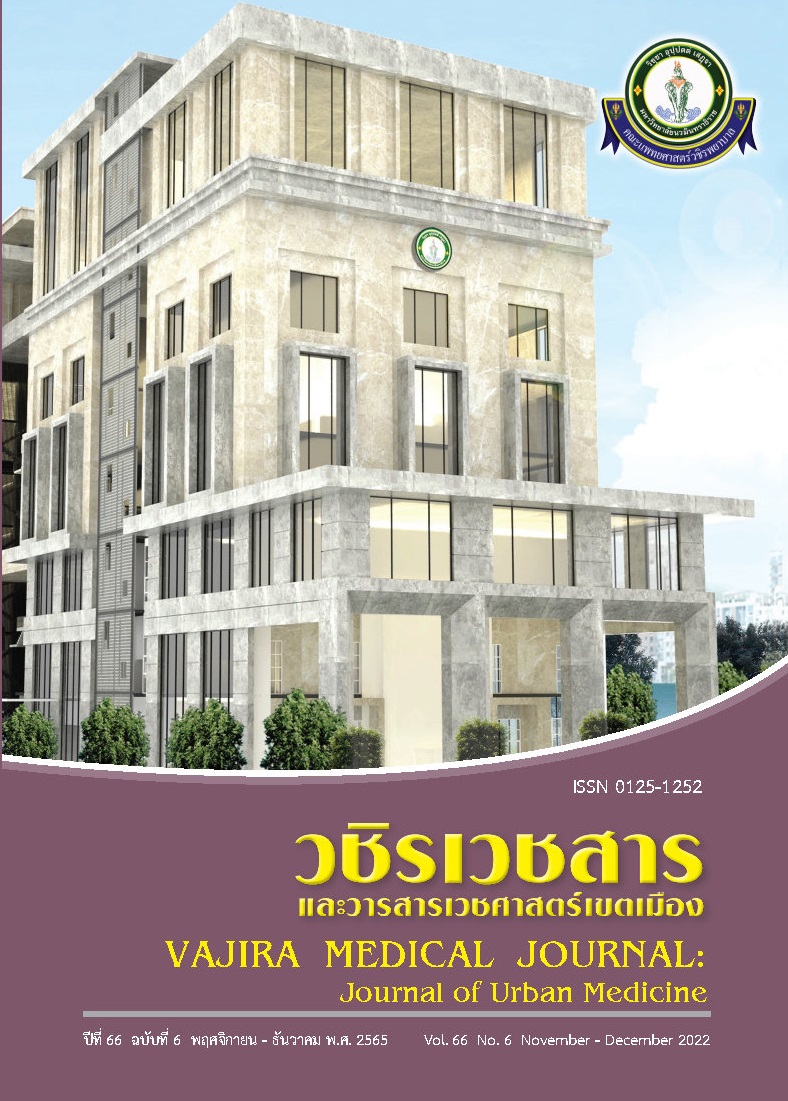Prevalence and Risk Factors of Positional Obstructive Sleep Apnea (POSA) among Children with Obstructive Sleep Apnea
Main Article Content
Abstract
Objective: This study aimed to assess the prevalence and risk factors of positional obstructive sleep apnea (POSA) among children with OSA.
Methods: A retrospective study was conducted. One hundred and three children with OSA who were aged 3 to 18 years between April 2013 and July 2021 were included in this study. Demographic and polysomnographic data were gathered.
Results: The prevalence of POSA was 42.7%. No significant differences were observed in age, gender, tonsil score, weight status and medical comorbidities. Children with POSA had a significantly higher supine AHI than non-POSA (9.6 [0.0-98.7] versus 4.7 [0.0-55.4], p = 0.012). The median non-supine AHI of POSA was significantly lower than non-POSA (0.0 [0.0-18.6] versus 5.3 [0.0-78.9], respectively p < 0.001).
Conclusion: POSA among children with OSA occurs frequently, similar to adults with POSA. POSA is associated with higher supine AHI and lower non-supine AHI. Positional therapy might be beneficial in children with POSA.
Downloads
Article Details

This work is licensed under a Creative Commons Attribution-NonCommercial-NoDerivatives 4.0 International License.
References
Lumeng JC, Chervin RD. Epidemiology of pediatric obstructive sleep apnea. Proc Am Thorac Soc 2008;5(2):242-52.
Narang I, Mathew JL. Childhood obesity and obstructive sleep apnea. J Nutr Metab 2012; 2012:134202.
Lee CF, Lee CH, Hsueh WY, Lin MT, Kang KT. Prevalence of obstructive sleep apnea in children with down syndrome: a meta-analysis. J Clin Sleep Med 2018;14(5):867-75.
Walter LM, Dassanayake DUN, Weichard AJ, Davey MJ, Nixon GM, Horne RSC. Back to sleep or not: the effect of the supine position on pediatric OSA: sleeping position in children with OSA. Sleep Med 2017;37:151-9.
Cartwright RD. Effect of sleep position on sleep apnea severity. Sleep 1984;7(2):110-4.
Verhelst E, Clinck I, Deboutte I, Vanderveken O, Verhulst S, Boudewyns A. Positional obstructive sleep apnea in children: prevalence and risk factors. Sleep Breath 2019;23(4):1323-30.
Selvadurai S, Voutsas G, Massicotte C, Kassner A, Katz SL, Propst EJ, et al. Positional obstructive sleep apnea in an obese pediatric population. J Clin Sleep Med 2020;16(8): 1295-301.
Frank MH, Ravesloot MJ, van Maanen JP, Verhagen E, de Lange J, de Vries N. Positional OSA part 1: towards a clinical classification system for position-dependent obstructive sleep apnoea. Sleep Breath 2015;19(2):473-80.
Cuhadaroglu C, Keles N, Erdamar B, Aydemir N, Yucel E, Oguz F, et al. Body position and obstructive sleep apnea syndrome. Pediatr Pulmonol 2003;36(4):335-8.
Dayyat E, Maarafeya MM, Capdevila OS, Kheirandish-Gozal L, Montgomery-Downs HE, Gozal D. Nocturnal body position in sleeping children with and without obstructive sleep apnea. Pediatr Pulmonol 2007;42(4):374-9.
Lee CH, Hsu WC, Chang WH, Lin MT, Kang KT. P o l y s o m n o g r a p h i c fi n d i n g s a f t e r adenotonsillectomy for obstructive sleep apnoea in obese and non-obese children: a systematic review and meta-analysis. Clin Otolaryngol 2016;41(5):498-510.
Marcus CL, Rosen G, Ward SL, Halbower AC, Sterni L, Lutz J, et al. Adherence to and effectiveness of positive airway pressure therapy in children with obstructive sleep apnea. Pediatrics 2006;117(3):e442-51.
Xiao L, Baker A, Voutsas G, Massicotte C, Wolter NE, Propst EJ, et al. Positional device therapy for the treatment of positional obstructive sleep apnea in children: a pilot study. Sleep Med 2021;85:313-6.
Salepun S, Srisura W, Sukjai S, Kongkajun S, Ladwilai N. Know your weight and height [Internet]. 2020 [cited 2022 Feb 18]. Available from: https://nutrition2.anamai.moph.go.th
Brodsky L. Modern assessment of tonsils and adenoids. Pediatr Clin North Am 1989;36(6): 1551-69.
Berry RB, Budhiraja R, Gottlieb DJ, Gozal D, Iber C, Kapur VK, et al. Rules for scoring respiratory events in sleep: update of the 2007 AASM manual for the scoring of sleep and associated events. Deliberations of the sleep apnea definitions task force of the American academy of sleep medicine. J Clin Sleep Med 2012;8(5):597-619.
Nisbet LC, Phillips NN, Hoban TF, O'Brien LM. Effect of body position and sleep state on obstructive sleep apnea severity in children with Down syndrome. J Clin Sleep Med 2014;10(1):81-8.
Joosten SA, O'Driscoll DM, Berger PJ, Hamilton GS. Supine position related obstructive sleep apnea in adults: pathogenesis and treatment. Sleep Med Rev 2014;18(1):7-17.
Marklund M, Persson M, Franklin KA. Treatment success with a mandibular advancement device is related to supine-dependent sleep apnea. Chest 1998;114(6):1630-5.
Mador MJ, Kufel TJ, Magalang UJ, Rajesh SK, Watwe V, Grant BJ. Prevalence of positional sleep apnea in patients undergoing polysomnography. Chest 2005;128(4):2130-7.
Bignold JJ, Mercer JD, Antic NA, McEvoy RD, Catcheside PG. Accurate position monitoring and improved supine-dependent obstructive sleep apnea with a new position recording and supine avoidance device. J Clin Sleep Med 2011;7(4):376-83.
Zhang XW, Li Y, Zhou F, Guo CK, Huang ZT. Association of body position with sleep architecture and respiratory disturbances in children with obstructive sleep apnea. Acta Otolaryngol 2007;127(12):1321-6.
Kirkham EM, Melendez JB, Hoi K, Chervin RD. Drug-induced sleep endoscopy in children with positional obstructive sleep apnea. Otolaryngol Head Neck Surg 2021;164(1): 191-8.
Chung JW, Enciso R, Levendowski DJ, Westbrook PR, Clark GT. Patients with positional versus nonpositional obstructive sleep apnea: a retrospective study of risk factors associated with apnea-hypopnea severity. Oral Surg Oral Med Oral Pathol Oral Radiol Endod 2010; 110(5):605-10.
Victores AJ, Hamblin J, Gilbert J, Switzer C, Takashima M. Usefulness of sleep endoscopy in predicting positional obstructive sleep apnea. Otolaryngol Head Neck Surg 2014;150(3): 487-93.


